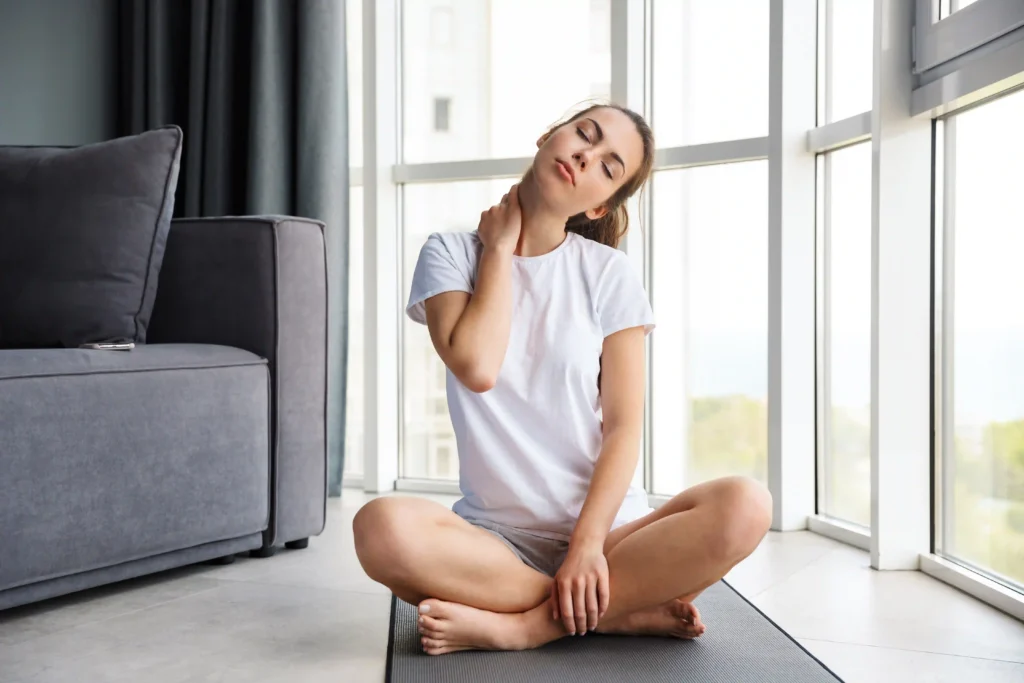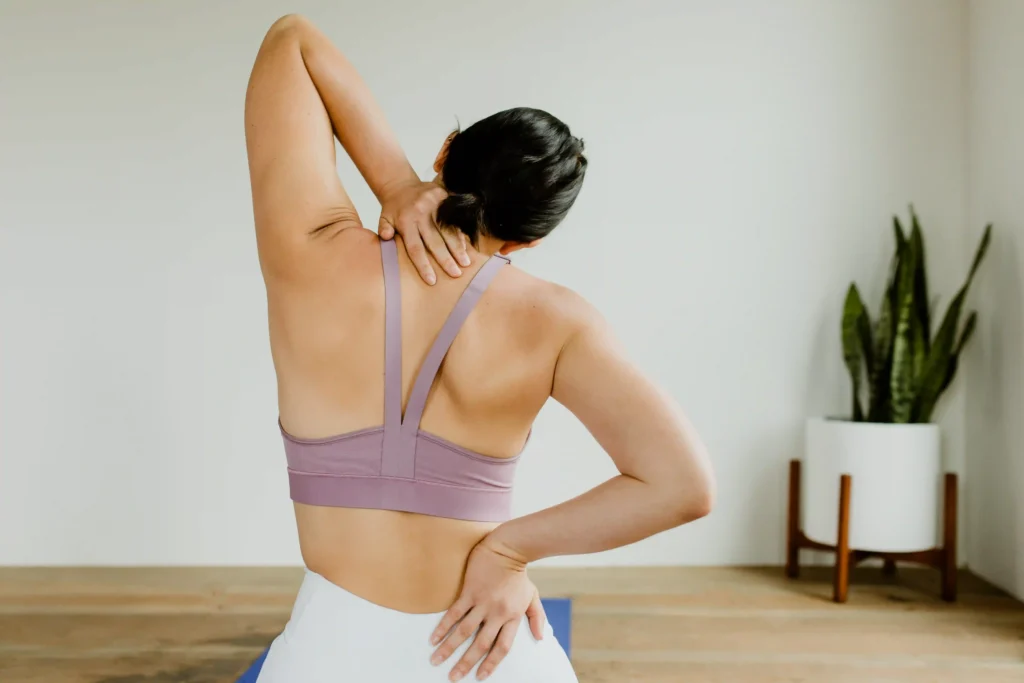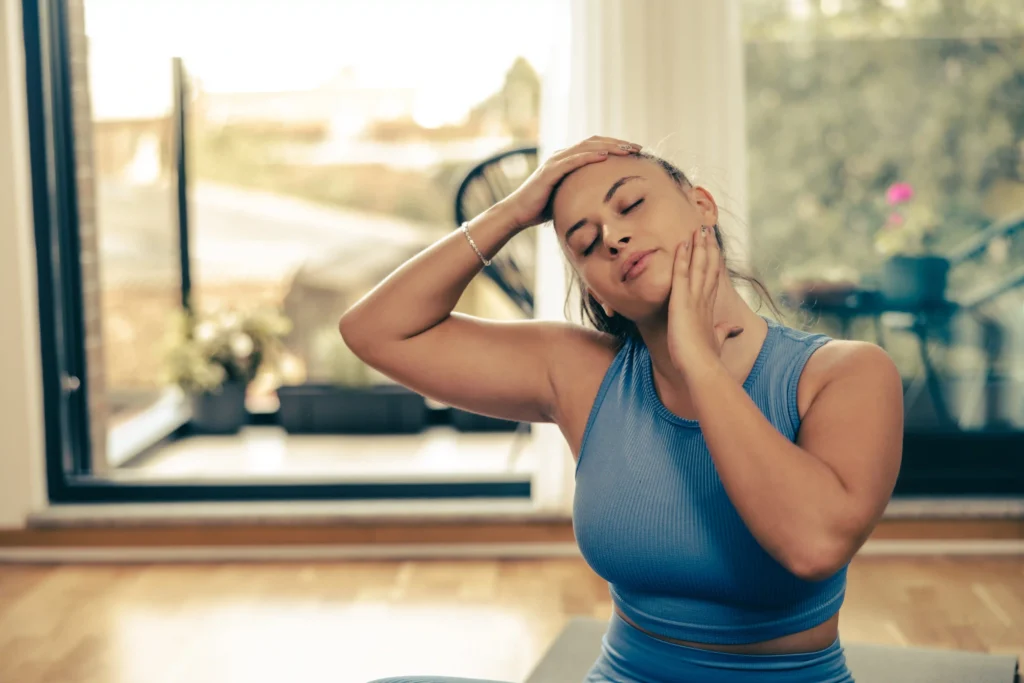
Table of Contents
Toggle“Neck pain relief yoga” refers to specific yoga practices tailored to alleviate discomfort and tension in the neck, shoulders, and upper back. By targeting muscles that support the neck, these yoga poses reduce pain, improve posture, and increase flexibility.
This practice is particularly beneficial for individuals dealing with stress or prolonged screen time, as it combines physical movement with mindfulness for long-term relief.

Neck pain often stems from everyday habits like sitting hunched over a desk or scrolling on a smartphone for hours. These activities lead to poor posture, also known as “tech neck,” where the head tilts forward, straining the neck muscles.
Additionally, stress and tension build up in the shoulders and upper back, contributing to chronic pain. As a spine surgeon with over 25 years of experience, I’ve seen firsthand how addressing these root causes can transform lives.
Yoga stands out as a natural remedy because it strengthens supporting muscles, improves flexibility, and encourages mindfulness. Unlike medications that only mask the pain, yoga promotes lasting relief by tackling the underlying issues.
Through consistent practice, patients often notice increased mobility, reduced discomfort, and an improved quality of life. Read more here.
When it comes to neck pain relief yoga, specific poses target tension and stiffness in the neck and shoulders. Child’s Pose is a favorite for many patients, offering gentle relief for tight shoulders and a stiff neck.
By extending your arms forward while resting your forehead on the mat, this pose elongates the spine and encourages relaxation. Cat-Cow Pose is another effective option.
This dynamic movement, alternating between arching and rounding the back, helps release tension along the entire spine. Thread the Needle provides a deep stretch for the shoulders and upper back while gently twisting the spine.
For those struggling with poor posture, Sphinx Pose counteracts the effects of slouching by strengthening the neck and opening the chest. Lastly, Cow Face Pose stretches the shoulders and upper arms, areas often overlooked in neck pain management.
These poses, combined with mindful breathing, not only alleviate discomfort but also create a sense of calm and balance.
Practicing neck pain relief yoga at home is a great way to integrate healing into your routine. Start by creating a comfortable space with a yoga mat, blocks, or blankets for support.
Focus on gentle movements and avoid poses that cause sharp pain. For example, if holding a full Child’s Pose feels difficult, use a pillow under your hips or forehead for additional support.
Proper alignment is key to avoiding injury. When performing poses like Cat-Cow or Sphinx, keep your movements slow and controlled, allowing your breath to guide each stretch.
Remember, yoga is not a competition—it’s about listening to your body and progressing at your own pace. If you’re new to yoga, consider following a guided video or joining a beginner class to build confidence and learn proper techniques.

If you’re dealing with severe neck pain or mobility limitations, modifications can make yoga accessible and effective. For seated poses like Cat-Cow, use a chair instead of getting on the floor.
This allows you to move your spine and neck without straining. Similarly, poses like Thread the Needle can be performed in a seated position by crossing one arm over the chest and gently stretching it.
Another helpful modification is using props like bolsters or blocks. These tools provide support in poses such as Child’s Pose or Sphinx, ensuring proper alignment and reducing strain.
For individuals with acute pain, focus on smaller movements like gentle neck tilts or shoulder rolls. These exercises build strength and flexibility over time, paving the way for more advanced poses as your comfort improves.
Consistency is more important than duration when it comes to neck pain relief yoga. Beginners can start with sessions lasting just 10–20 minutes daily.
The key is to focus on quality over quantity, ensuring each pose is performed mindfully and with proper alignment. Over time, as your comfort level increases, you can extend your practice to 30 minutes or more.
Each pose should be held for 5–10 breaths, allowing the muscles to stretch and relax. Incorporating a few minutes of meditation or deep breathing at the end of your session can enhance its calming effects.
Based on my professional experience, patients who commit to regular yoga practice often report noticeable improvements in pain and mobility within a few weeks.
While yoga is generally safe, certain precautions can help prevent further aggravation of neck pain. Avoid hyperextending the neck in poses like Bridge Pose, where improper alignment can strain the muscles.
Instead, keep your head and neck neutral to maintain balance and safety. Focus on relaxing your shoulders during each pose, as tension here often exacerbates neck pain.
Listen to your body—if a movement feels uncomfortable or causes sharp pain, stop immediately. Warm up with gentle stretches like neck rolls before diving into more intense poses.
Finally, stay hydrated and ensure you’re practicing in a space that allows freedom of movement.

Yoga offers a unique combination of physical and mental benefits, making it an excellent alternative to traditional treatments like medication or physical therapy. Unlike painkillers, which only provide temporary relief, yoga addresses the root causes of neck pain through stretching, strengthening, and mindfulness.
It’s also cost-effective and accessible, requiring minimal equipment. When compared to physical therapy, yoga complements these sessions by improving flexibility and body awareness.
For many of my patients, combining yoga with therapeutic exercises enhances overall outcomes. Additionally, yoga’s emphasis on relaxation helps reduce stress—a common trigger for neck pain—providing a holistic approach to healing.
One of the most significant benefits of yoga is its ability to prevent recurring neck pain. Regular practice strengthens the muscles that support the neck and shoulders, improving posture and reducing strain.
By increasing flexibility, yoga makes these areas less prone to injury during daily activities. Yoga also encourages mindfulness, which fosters better habits, like maintaining an ergonomic workspace and taking breaks from screen time.
Through consistent practice, you’ll notice a heightened awareness of your body’s needs, enabling you to address tension before it becomes a problem. This proactive approach is key to long-term relief and improved overall health.
To maximize the benefits of neck pain relief yoga, consider incorporating complementary techniques like breathing exercises. Pranayama, or yogic breathing, helps calm the nervous system and reduce stress, enhancing the relaxation achieved during poses.
Meditation is another powerful tool, promoting mental clarity and reducing tension. In addition to yoga, make ergonomic adjustments to your workspace.
Use a supportive chair and position your screen at eye level to maintain a neutral neck position. Self-myofascial release with a foam roller or massage ball can also relieve tightness in the shoulders and upper back.
These practices, combined with yoga, create a well-rounded approach to managing neck pain. Read more here.
Integrating yoga into your daily routine doesn’t have to be time-consuming. Start your morning with a short sequence of poses like Child’s Pose, Cat-Cow, and Sphinx to set a positive tone for the day.
During work breaks, perform seated variations of poses to release tension without leaving your desk. Set reminders to practice consistently, even if it’s just for a few minutes.
Pair yoga with other healthy habits, such as taking a walk or staying hydrated, to reinforce its benefits. By making yoga a regular part of your life, you’ll not only find relief from neck pain but also experience greater overall well-being.
GET IN TOUCH +
285 Sills Road
Building 5-6, Suite E
East Patchogue, NY 11772
(631) 475-5511
184 N. Belle Mead Road
East Setauket, NY 11733
(631) 675-6226
GET IN TOUCH +
285 Sills Road
Building 5-6, Suite E
East Patchogue, NY 11772
(631) 475-5511
184 N. Belle Mead Road
East Setauket, NY 11733
(631) 675-6226
SUBSCRIBE TO OUR NEWSLETTER +
Send us a Google review. Click this link and let us know how we did!
Review us on Yelp too.